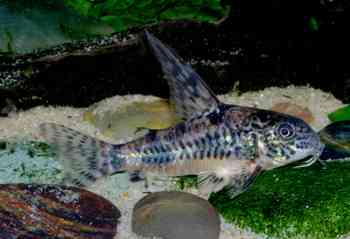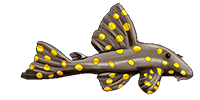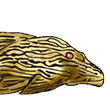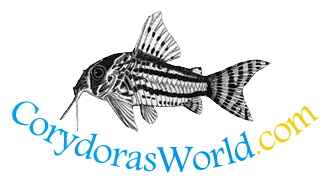Wild caught high fin C. paleatus
-
Marc van Arc
- Expert
- Posts: 5038
- Joined: 19 Dec 2004, 14:38
- My articles: 20
- My images: 61
- My catfish: 9
- Spotted: 35
- Location 2: Eindhoven, The Netherlands
Wild caught high fin C. paleatus
I don't know if this question has been raised before, but several LFS-ses here offer wild caught C. paleatus with elongated pectoral and dorsal spines. They look like a cross between S. macropterus and C. paleatus, although the largest part of this species would be paleatus orientated (highly built and rather short in length).
It's not the commonly available pathetic man-made hi fin paleatus, because only the dorsal and pectorals are enlongated.
Who fills me in?
It's not the commonly available pathetic man-made hi fin paleatus, because only the dorsal and pectorals are enlongated.
Who fills me in?
- Coryman
- Expert
- Posts: 2119
- Joined: 30 Dec 2002, 19:06
- My articles: 12
- My catfish: 5
- My cats species list: 83 (i:3, k:0)
- My BLogs: 1 (i:0, p:46)
- Spotted: 194
- Location 1: Kidderminster UK
- Location 2: Kidderminster, UK
- Interests: Cory's, Loricariids, photography and more Cory's
- Contact:
-
Marc van Arc
- Expert
- Posts: 5038
- Joined: 19 Dec 2004, 14:38
- My articles: 20
- My images: 61
- My catfish: 9
- Spotted: 35
- Location 2: Eindhoven, The Netherlands
- MatsP
- Posts: 21038
- Joined: 06 Oct 2004, 13:58
- My articles: 4
- My images: 28
- My cats species list: 117 (i:33, k:0)
- My aquaria list: 12 (i:10)
- My BLogs: 4 (i:0, p:164)
- Spotted: 187
- Location 1: North of Cambridge
- Location 2: England.
- Coryman
- Expert
- Posts: 2119
- Joined: 30 Dec 2002, 19:06
- My articles: 12
- My catfish: 5
- My cats species list: 83 (i:3, k:0)
- My BLogs: 1 (i:0, p:46)
- Spotted: 194
- Location 1: Kidderminster UK
- Location 2: Kidderminster, UK
- Interests: Cory's, Loricariids, photography and more Cory's
- Contact:
I have it on good authority that the best temperature for these is a maximum of 17º C and that they do not breed above this. A fact that is proving true for my group at least. I think I will put them in an outside pool in the late spring.

The first three soft dorsal rays become greatly extended with age.
Ian

The first three soft dorsal rays become greatly extended with age.
Ian
Last edited by Coryman on 20 Dec 2006, 13:57, edited 1 time in total.
-
Marc van Arc
- Expert
- Posts: 5038
- Joined: 19 Dec 2004, 14:38
- My articles: 20
- My images: 61
- My catfish: 9
- Spotted: 35
- Location 2: Eindhoven, The Netherlands
Today I bought a group of these. Not only because they are good looking, but also because there's a niche in my tank they fit in; there are no fishes that stir up and /or dig into the sand. The Dianema urostriatum are unwilling to do so and with lots of small bogwood and plants much dirt remained in the tank so far.
Unfortunately I read just now that they feel comfortable at a rather low temperature.....Can't keep them on 17 C, because their tankmates like it a little warmer. We'll see what happens. At the moment they are very happy with my riversand; the LFS tank had gravel.
Unfortunately I read just now that they feel comfortable at a rather low temperature.....Can't keep them on 17 C, because their tankmates like it a little warmer. We'll see what happens. At the moment they are very happy with my riversand; the LFS tank had gravel.
-
Marc van Arc
- Expert
- Posts: 5038
- Joined: 19 Dec 2004, 14:38
- My articles: 20
- My images: 61
- My catfish: 9
- Spotted: 35
- Location 2: Eindhoven, The Netherlands
-
Bas Pels
- Posts: 2918
- Joined: 21 Dec 2006, 20:35
- My images: 1
- My cats species list: 28 (i:0, k:0)
- Spotted: 8
- Location 1: the Netherlands
- Location 2: Nijmegen the Netherlands
- Interests: Central American and Uruguayan fishes
My very first posing on this great forum........
In January last I visited Uruguay, and brought a lot of fishes with me. Among these 2 species of Corydoras, one from a little stream, Arroya Tropa Vieja, near the town Salinas, 30 km west of Montevideo, the other from a lake near the town Treinta y Tres.
The latter are almost exactly like the one coryman showed. That is, the males. The females are just like all C paleatus.
As Uruguay is semi-tropical, having a climate comparable with south Portugal / north Africa, the fishes (all) are currently at 8-12 degrees centigrade (I just keep the window open)
In summer they were outdoors, in ponds placed on the ground, facing south and the water has reached 37 degrees centigrades - followed by the 'coolness' of the night.
Bas
In January last I visited Uruguay, and brought a lot of fishes with me. Among these 2 species of Corydoras, one from a little stream, Arroya Tropa Vieja, near the town Salinas, 30 km west of Montevideo, the other from a lake near the town Treinta y Tres.
The latter are almost exactly like the one coryman showed. That is, the males. The females are just like all C paleatus.
As Uruguay is semi-tropical, having a climate comparable with south Portugal / north Africa, the fishes (all) are currently at 8-12 degrees centigrade (I just keep the window open)
In summer they were outdoors, in ponds placed on the ground, facing south and the water has reached 37 degrees centigrades - followed by the 'coolness' of the night.
Bas
-
Marc van Arc
- Expert
- Posts: 5038
- Joined: 19 Dec 2004, 14:38
- My articles: 20
- My images: 61
- My catfish: 9
- Spotted: 35
- Location 2: Eindhoven, The Netherlands
Ian,Coryman wrote: A fact that is proving true for my group at least.
My corys have the habit of sitting motionless on the leaves just below the surface during the day. Imo all things should be well for them, except the temperature (24C).
Have you ever witnessed this behaviour with your group as well?
- Coryman
- Expert
- Posts: 2119
- Joined: 30 Dec 2002, 19:06
- My articles: 12
- My catfish: 5
- My cats species list: 83 (i:3, k:0)
- My BLogs: 1 (i:0, p:46)
- Spotted: 194
- Location 1: Kidderminster UK
- Location 2: Kidderminster, UK
- Interests: Cory's, Loricariids, photography and more Cory's
- Contact:
-
Marc van Arc
- Expert
- Posts: 5038
- Joined: 19 Dec 2004, 14:38
- My articles: 20
- My images: 61
- My catfish: 9
- Spotted: 35
- Location 2: Eindhoven, The Netherlands






